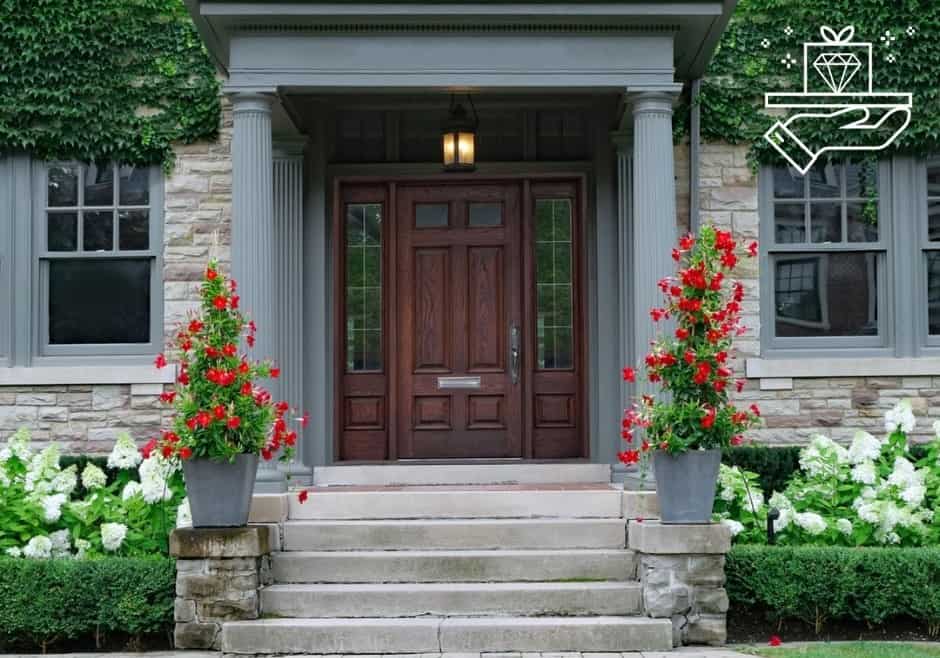The front door of your home serves as a gateway, not only for you and your guests but also for positive energy and opportunities. One of the best ways to make your entryway warm, inviting, and aesthetically pleasing is by adorning it with the right plants.
In this guide, we’ll explore a curated selection of plants for your front door, each chosen for its unique beauty, auspicious symbolism, and potential to harmonize with the principles of Feng Shui.
Choosing the Right Plants for Your Front Door


Before you rush to the nearest nursery, consider the specific needs of your front door area. Assess the amount of sunlight it receives and the climate of your region.
Some plants thrive in bright sunlight, while others prefer shaded spots. Additionally, think about the available space and how much time you can dedicate to plant maintenance.
For low-maintenance options, opt for hardy plants that require minimal care, while those willing to invest time can go for high-maintenance varieties that offer a more visually rewarding experience.
Top 7 Plants for Front Door Decor
Lucky Bamboo


Botanical Name: Dracaena sanderiana
Origin: Southeast Asia
Size: Typically up to 2-3 feet tall, depending on container and growing conditions
Light: Indirect sunlight or moderate shade
Water: Keep the roots submerged in water and change the water every two weeks to prevent stagnation.
Toxicity: Non-toxic
Lucky bamboo is a symbol of good luck, prosperity, and growth in Feng Shui. It’s commonly used for attracting positive energy and maintaining a harmonious environment.
Its elegant and graceful appearance makes it a popular choice for front door decoration.
You can place lucky bamboo in water-filled vases or pots filled with well-draining soil. Ensure it receives indirect light, and you can even experiment with different shapes by training the stems.
Peace Lily


Botanical Name: Spathiphyllum
Origin: Tropical regions of the Americas and Southeast Asia
Size: Up to 1-4 feet, depending on the variety and growing conditions
Light: Low to moderate light conditions
Water: Maintain soil moisture consistently, avoiding excessive waterlogging
Toxicity: Mildly toxic if ingested
Known for its air-purifying qualities, the peace lily is considered beneficial in Feng Shui. It helps improve indoor air quality and can also bring peace and tranquility to the surroundings.
Peace lilies thrive in well-lit areas with indirect sunlight and require regular, moderate watering. You can choose decorative containers to complement its lush, dark green leaves and white flowers.
Snake Plant


Botanical Name: Sansevieria trifasciata
Origin: West Africa
Size: Up to 2-4 feet tall
Light: Can thrive in low light conditions but can also tolerate bright, indirect light
Water: Ensure the soil has dried out before each watering
Toxicity: Mildly toxic if ingested
For a low-maintenance and stylish addition to your front door area, consider the snake plant. It has robust, sword-like leaves that come in various patterns.
The snake plant is praised for its resilience and ability to purify the air. In Feng Shui, it is believed to absorb negative energy, making it a popular choice for entryways.
This plant can tolerate low light conditions and irregular watering, making it perfect for busy households.
Pothos


Botanical Name: Epipremnum aureum
Origin: Southeast Asia
Size: Up to 6-10 feet long
Light: Low to moderate light conditions and can tolerate some fluorescent lighting
Water: Allow the soil to dry out between waterings and avoid overwatering
Toxicity: Toxic if ingested
Pothos is a versatile and beautiful trailing plant that is associated with luck and prosperity in Feng Shui. Its vibrant and heart-shaped leaves that come in different colors are believed to attract positive energy.
Pothos flourishes in bright, indirect light but can adapt to lower light levels too. Consider placing it in hanging baskets to create an eye-catching display.
Geraniums


Botanical Name: Pelargonium
Origin: Southern Africa
Size: Up to 1-3 feet
Light: At least 4-6 hours of sunlight per day
Water: Keep the soil slightly moist but avoid overwatering
Toxicity: Non-toxic
Geraniums are often used in Feng Shui to attract love and positive relationships.
These cheerful and vibrant flowers come in various hues, making them perfect for adding a splash of color and brightening up your entryway. Geraniums prefer ample sunlight, so ensure they receive at least 4-6 hours of sunlight each day.
Lavender


Botanical Name: Lavandula
Origin: Mediterranean region
Size: Up to 1-3 feet tall
Light: Full sun for at least 6-8 hours daily to thrive and produce abundant blooms
Water: Allow the soil to dry out between waterings and avoid excessive watering
Toxicity: Non-toxic
Lavender is known for its soothing fragrance and beautiful purple flowers. It not only adds visual appeal but also brings a sense of calm and relaxation to your front door area.
In Feng Shui, it’s used to promote relaxation and peacefulness in the home.
Lavender thrives in well-draining soil and requires plenty of sunlight, making it suitable for sunny entryways.
Rubber Plant


Botanical Name: Ficus elastica
Origin: Southeast Asia
Size: Up to 2-10 feet tall
Light: Bright, indirect light
Water: Keep the soil evenly moist during the growing season, but reduce watering in the winter months
Toxicity: Mildly toxic if ingested
The rubber plant is a statement piece with its large, glossy leaves. It’s considered auspicious in Feng Shui, signifying prosperity and abundance.
To keep it looking its best, place the rubber plant in bright, indirect light and avoid overwatering.
Maintenance Tips for Front Door Plants


To ensure that your front door plants thrive and continue to welcome guests with their vibrant beauty, it’s essential to provide them with proper care and attention. Follow these maintenance tips to keep your plants healthy and flourishing:
- Watering: Appropriate watering is essential for the health and vitality of your plants. Different plants have varying water needs, so it’s essential to understand the specific requirements of each species.
Overwatering may cause root rot while underwatering can lead to dehydration. Striking the right balance is vital.
Check the soil regularly, and water your plants when the top inch of the soil feels dry to the touch. Consider using a drip irrigation system or a watering can with a fine nozzle for more precise watering.
- Sunlight: Sunlight is the lifeblood of plants, as it provides the energy they need for photosynthesis. Observe the amount of sunlight your front door area receives throughout the day.
Some plants prefer full sun, while others thrive in partial or even full shade. Position your plants accordingly, ensuring they get the appropriate amount of light to thrive.
- Pruning and Trimming: Regular pruning and trimming are essential for maintaining the shape and health of your plants. Trim away any dead or yellowing leaves to promote new growth and prevent the spread of diseases.
Prune back any overgrown branches to encourage a fuller and more attractive appearance. Make sure to use clean and sharp pruning tools to make precise cuts.
- Repotting: As your plants grow, they may outgrow their containers and become root-bound. When you notice the roots tightly filling the pot, it’s time to repot your plant into a larger container.
Repotting provides the plant with fresh soil and more space for its roots to spread and access nutrients. Be sure to be gentle during the repotting process to avoid damaging the roots.
- Fertilization: Fertilizing your front door plants helps replenish essential nutrients that may deplete over time. Choose a balanced, slow-release fertilizer or organic compost to provide a steady supply of nutrients to your plants.
Follow the recommended fertilizing schedule for each plant, as overfertilization can lead to nutrient imbalances and harm the plant.
- Pest and Disease Management: Monitor your plants for any indications of pests or diseases. Common pests like aphids, spider mites, and whiteflies can infest your plants and cause damage.
Use natural remedies or organic insecticides to manage pests without harming beneficial insects. If you notice any signs of diseases like wilting, discoloration, or unusual growth, take prompt action to prevent the spread to other plants.
The Art of Feng Shui in Front Door Gardening


Incorporating Feng Shui principles into your front door gardening can have a profound impact on the energy flow and ambiance of your home. By strategically placing plants and considering their symbolism, you can invite positive chi (energy) into your space.
Here are some essential tips to harness the power of Feng Shui in your front door gardening:
- Place Plants with Rounded Leaves at the Front Door: In Feng Shui, plants with rounded leaves are associated with abundance and prosperity. The circular shape symbolizes completeness and unity.
Using plants like the peace lily or the rubber plant welcome positive energy into your home with their lush, rounded leaves. Place them in decorative pots near your front door to create an inviting and harmonious atmosphere.
- Use Plants with Upward Growth: Plants that exhibit upward growth are believed to promote vitality, progress, and positive energy.
These upward-reaching plants symbolize growth and ambition, making them perfect for the entryway.
Choose plants like lucky bamboo or snake plant, which exhibit vertical growth patterns, to encourage a sense of upward movement and positive intentions.
- Arrange Plants in Pairs or Groups: Pairing or grouping plants is a powerful way to promote unity and harmony in your front door area. In Feng Shui, this practice represents the balance of yin and yang energies.
Consider placing two identical plants or different species with complementary colors and shapes, such as lucky bamboo and snake plant, on either side of the front door.
This arrangement invites a sense of balance and attracts positive energy to your home.
- Keep the Front Door Area Clutter-Free: A cluttered front door area can hinder the flow of positive energy into your home. Clear any unnecessary objects or obstacles from the entryway to allow energy to move freely.
This practice encourages a smooth and inviting transition from the outside world to your home’s interior. Keep the space clean, organized, and well-maintained to create a welcoming atmosphere for both guests and positive energy.
- Choose Colors Wisely: In addition to plant selection, consider the colors of your front door and the plants you use. Certain colors are associated with specific energies in Feng Shui.
For example, red is believed to attract prosperity and good luck, while green represents growth and renewal. Choose colors that resonate with your intentions and preferences while aligning with the principles of Feng Shui.
Styling Your Front Door


Styling your front door with plants is an opportunity to showcase your creativity and infuse your entryway with a welcoming and personalized touch.
Here are some tips to help you style your front door:
- Choose Planters and Pots with Care: The choice of planters and pots is just as significant as the selection of plants themselves. Opt for containers that complement the overall aesthetic of your entryway.
Consider the architectural style and color scheme of your home when selecting planters. Classic terracotta pots can add a rustic charm, while modern and sleek planters can give a contemporary look.
Alternatively, wooden or woven baskets can add a touch of natural warmth to the setting.
- Create a Welcoming Atmosphere with Decorative Elements: Enhance the visual appeal of your front door area by incorporating other decorative elements alongside your plants.
Consider placing pebbles or decorative rocks around the base of the planters to add texture and depth. Small statues or figurines can lend a touch of personality and charm.
Wind chimes or hanging mobiles can create a soothing melody as they gently sway in the breeze. However, be sure not to overcrowd the space, as simplicity and balance are essential in front door styling.
- Pay Attention to Seasonal Changes: For an ever-changing and captivating front door display, consider seasonal variations. Select plants that thrive in different seasons to ensure your entryway remains vibrant throughout the year.
Spring flowers, summer blooms, autumnal foliage, and winter evergreens can each take center stage at their respective times, keeping your front door area fresh and inviting.




